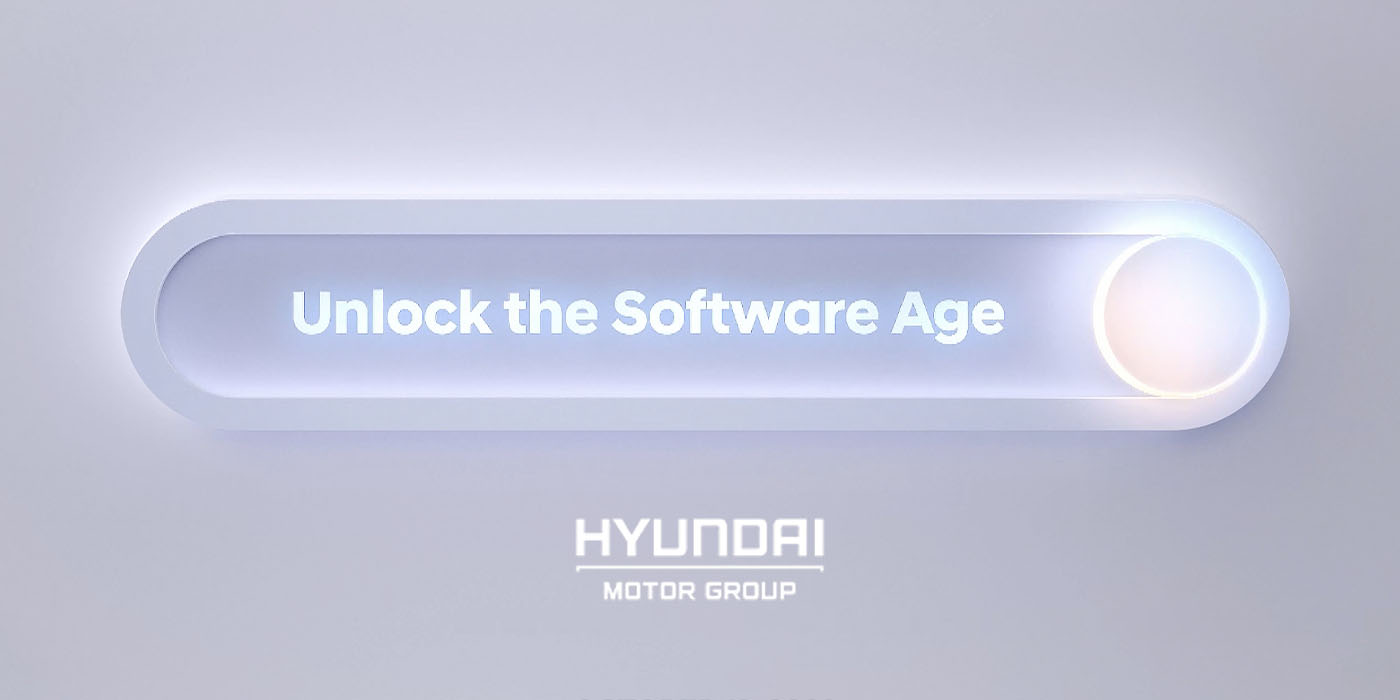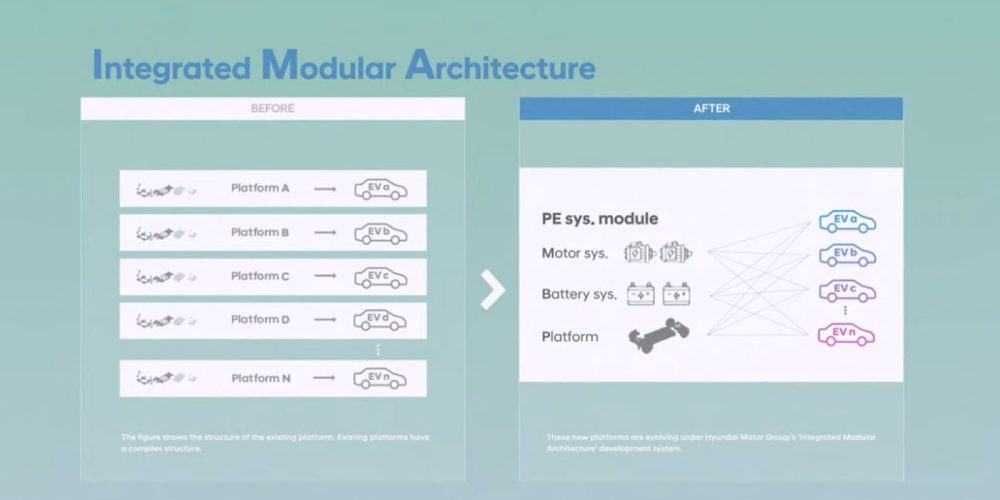
Following its “Unlock the Software Age” global forum earlier this evening, Hyundai Motor Group has outlined a detailed roadmap to transform its entire lineup of vehicles (gas and electric) across all brands into Software Defined Vehicles (SDVs) by 2025. This new era of vehicle technology will allow HMG to constantly evolve along with its vehicles, which will be able to stay up-to-date via over-the-air updates. To support this new era, the Group has already committed to spending 18 trillion won (~$12.5 billion) to establish a new Global Software Center and accelerate SDV development.
By now you’re likely well aware of Hyundai Motor Group and its three current automotive marques – Hyundai, Kia, and Genesis. The IONIQ brand of EVs still currently exists under the Hyundai marque as well as the larger HMG banner.
There’s a lot to unfold here following the group’s recent livestream from South Korea, so we will skip the history lesson for today and hop right into the future. As EVs especially develop toward a new era that’s much more dependent on semiconductors and software than moving parts, a new era of mobility is beginning to emerge.
Hyundai Motor Group states that it recognized this years ago and has been working behind the scenes to ensure its current and future lineup of vehicles across all brands remain not just functional, but technologically relevant. Over-the-air (OTA) updates are already common among most automakers these days, but most of those capabilities are quite limited. For instance, many automakers can only push through simple updates to infotainment systems like the latest maps in navigation.
Only a few current automakers, such as Tesla and NIO for instance, are able to offer software and firmware updates over-the-air, allowing for added performance through an internet connection.
The nucleus of Hyundai’s presentation today was this focus on connectivity and transitioning to Software Defined Vehicles that can not only be remotely upgraded, but exist as part of a cutting-edge world of automotive telecommunication that provides owners with personalized services, safety, and even software subscriptions.
Hyundai can then use that connected car data for future mobility applications, such as Purpose Built Vehicles, Advanced Air Mobility, robotaxis, and even robots.
By 2025, Hyundai Motor Group looks to transform each and every one of its vehicles to fit into this new category of Software Defined Vehicles.

HMG expects 20 million Software Defined Vehicles by 2025
According to the release, all new vehicles from Hyundai Motor Group from 2023 onward will be equipped with OTA capabilities. This will include all HMG vehicles, not just EVs. By 2025, Hyundai states that it expects 20 million to be registered to its Connected Car Services (CCS) around the globe.
In addition to being able to upgrade the performance and functionality of a given vehicle anywhere at any time, Hyundai drivers will also be able to take advantage of Feature On-Demand (FoD) services next year as well. This will allow customers to pick and choose certain features or functions on their vehicle to further customize it to meet their specific needs. HMG plans to gather data generated by the 20 million connected vehicles and use it to further develop personalization services.
To roll out this ambitious arsenal of Software Defined Vehicles, Hyundai Group outlines five floors of the “software house” (seen above) that is the foundation of the new era in mobility.
- Vehicle Platform
- Electrical/Electronics Architecture
- Software Platform
- Data Platform
- Future of Mobililty
Hyundai’s roadmap starts on the ground floor and works its way up. Beginning in 2025, HMG will introduce two new EV platforms – eM and eS – built upon its Integrated Modular Architecture (IMA). eM is currently being developed to support EVs across all segments, and Hyundai says it will deliver 50% more range on a single charge compared to current EVs. It is also being built with Level 3 and higher autonomous driving in mind. So when that technology does become more mainstream, new Hyundai vehicles can already holster it. Same goes for OTA updates.
The eS platform is more of a traditional “skateboard” design exclusively for Purpose Built Vehicles, offering modular, tailor-made solutions to businesses in segments like logistics, rideshare, and last-mile deliveries.
Hyundai shared that its IMA technology will deliver a new level of standardization and modularity to the design and assembly of its EVs. By standardizing components like batteries and motors that currently vary by model, HMG says it can streamline its production processes and expand its lineup.

The same thought process applies to the vehicle controller, which previously required a vehicle’s software system to be upgraded separately for each one. By integrating the controller, future EVs will be more efficient in that the lower-level components can be managed by higher-level controllers, thus reducing the overall number required.
Another huge factor will be the group’s Connected Car Operating Systems (ccOS), which will be applied to all controllers within the vehicle to maximize hardware performance by way of top-tier computing power. Hyundai shared that it is currently collaborating with NVIDIA to load an optimized ccOS onto an NVIDIA DRIVE semiconductor.
Lastly, NVIDIA may or may not end up collaborating on Hyundai’s third-generation integrated controller, but when it does arrive, the company states it will become the basis for expansion into mass-producing Level 3 autonomous EVs and eventually commercializing Level 4 and Level 5 autonomous driving capabilities… “in due course.”
As one would surmise, a future with Software Defined Vehicles includes a lot of data, so a platform that can combine and process it throughout a vehicle’s life cycle will be vital. That’s why it’s the fourth floor of Hyundai Group’s “Software House.” Eunsook Jin, executive vice president and head of the ICT innovation division at HMG, explained:
Hyundai Motor Group’s data platform will not only be simply for driving. It will also play an important role in enhancing the convenience and diversity of the customer’s mobility experience by engaging throughout the vehicle’s entire life cycle. Going forward, we’ll also help create a new mobility ecosystem, connecting cars with other mobility devices, based on data connectivity and scalability.
The achieve all these goals to truly bring an entire lineup of Software Defined Vehicles to life, Hyundai will erect a Global Software Center where much of the $12.5 billion will be spent by 2030. The funds will also go toward other vital sectors like its R&D headquarters. While the Group appears confident in its current role in the automotive industry, it appears to just be getting started. Per the release:
As the Group embarks on a new challenge to transform mobility and meet the needs of customers in the future, it will also continue to develop its award-winning models to meet the needs of customers today. The appeal of the Group’s customer offerings has been consistently affirmed, as demonstrated recently by the range of awards bestowed on EV models from the Hyundai, Kia and Genesis brands by critics and media across the globe. Already today, the Group’s cutting-edge SDV technologies, such as Infotainment, Connectivity and ADAS are proving highly popular with customers, and as the technology rapidly develops further, a whole new world of possibilities will open up. This will pace the Group at the forefront of providing entirely new mobility solutions as society changes, transportation means evolve, and software-defined vehicles become commonplace.
There’s a lot more to unfold surrounding Hyundai’s future of Software Defined Vehicles, so we recommend checking out the company’s full release. Here’s the “Unlock the Software Age” presentation as well:
FTC: We use income earning auto affiliate links. More.




Comments